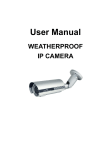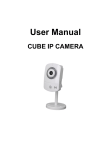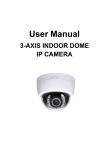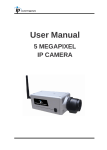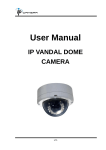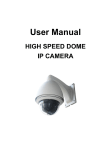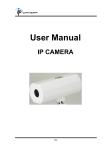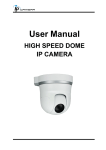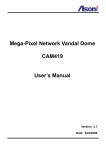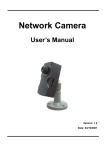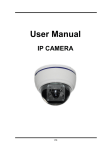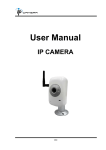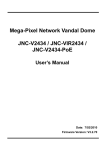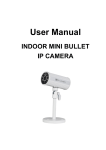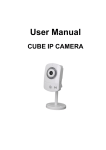Download USER MANUAL - sertech indonesia
Transcript
User Manual IP CAMERA 1/76 WARNING TO REDUCE THE RISK OF FIRE OR ELECTRIC SHOCK, DO NOT EXPOSE THIS PRODUCT TO RAIN OR MISTURE. DO NOT INSERT ANY METALLIC OBJECT THROUGH VENTILATION GRILLS. CAUTION CAUTION RISK OF ELECTRIC SHOCK DO NOT OPEN CAUTION:TO REDUCE THE RISK OF ELECTRIC SHOCK. DO NOT REMOVE COVER (OR BACK). NO USER-SERVICEABLE PARTS INSIDE. REFER SERVICING TO QUALIFIED SERVICE PERSONNEL. COPYRIGHT THE TRADEMARKS MENTIONED IN THE MANUAL ARE LEGALLY REGISTERED TO THEIR RESPECTIVE COMPANIES. 2/76 Content I. PREFACE ............................................................................................................ 4 II. PRODUCT SPECIFICATIONS ............................................................................. 4 III. PRODUCT INSTALLATION ................................................................................. 7 A. MONITOR SETTINGS ............................................................................................ 7 B. HARDWARE INSTALLATION .................................................................................... 8 C. IP ASSIGNMENT ................................................................................................ 10 D. INSTALL ACTIVEX CONTROL: ............................................................................... 13 IV. LIVE VIDEO ....................................................................................................... 21 V. IP CAMERA CONFIGURATION ........................................................................ 25 A. SYSTEM ........................................................................................................... 26 B. NETWORK ........................................................................................................ 31 C. A/V SETTINGS .................................................................................................. 44 D. EVENT LIST ...................................................................................................... 53 VI. NETWORK CONFIGURATION .......................................................................... 64 VII. I/O CONFIGURATION ....................................................................................... 66 VIII. FACTORY DEFAULT ......................................................................................... 69 IX. UNIVERSAL PASSWORD ................................................................................. 70 X. PACKAGE CONTENTS ..................................................................................... 74 XI. SD CARD COMPATIBILITY............................................................................... 75 V1.0_20130918 3/76 I. Preface This is a 1 / 3” Sony Exview CCD sensor Outdoor IP camera with the web server built in. User can view real-time video via IE browser. It supports H.264, and M-JPEG video compression which provides smooth and high video quality. The video can be stored in the SD card and playback remotely. With user friendly interface, it is an easy-to-use IP camera which is designed for security application. II. Product Specifications Sony Progressive CCD 720P CCD Outdoor IP Camera 3D+2D Digital Noise Reduction Digital Wide Dynamic Range Day & Night Switch Time Control Manually IR-Cut filter (Option) Power over Ethernet Available Video Output 2-way Audio H.264/ M-JPEG Compression SD Card Backup Support iPhone/iPad/Mac Triple Streaming SDK for Software Integration Free Bundle 36 ch recording software 4/76 Specifications Hardware CPU Multimedia SoC RAM 256MB Flash 16MB Image sensor 1 / 3” Sony Exview CCD sensor Sensitivity Color: 0.5 Lux (AGC ON) B / W: 0.1 Lux (AGC ON) Support DC IRIS YES Lens Changeable Yes, CS Mount ICR Mechanism IR cut-filter Audio G.711(64K) and G.726(32K,24K) audio compression Input : Mic built-in Output: 3.5mm phone jack, Support 2-way. I/O 1 D.I. / 1 D.O. Power over Ethernet Yes Power Consumption DC 12V Max:2.76W AC 24V Max:2.64W PoE Max:3.36W Operating Temperature 0°C ~ 45°C Dimensions 65mm (W) x 58mm (H) x 132mm (L) Weight 450g Network Ethernet 10/ 100 Base-T Network Protocol IPv6, IPv4, HTTP, HTTPS, SNMP, QoS/DSCP, Access list, IEEE 802.1X, RTSP, TCP/ IP, UDP, SMTP, FTP, PPPoE, DHCP, DDNS, NTP, UPnP, 3GPP, SAMBA, Bonjour Wireless (Optional) Wireless: 802.11b/g/n Security: WEP,WPA-PSK,WPA2-PSK 5/76 System Power Consumption DC 12V Max:3.48W (Wireless) AC 24V Max:4.08W Video Resolution Video Adjust 1280x720@30fps, 640x480@30fps, 320x240@30fps, 176x144@30fps Brightness, Contrast, Hue, Saturation, Sharpness, AGC, Night Mode, WDR, Flip, Mirror, Noise reduction, Day&Night adjustable, White Balance Triple Streaming Yes Image Snapshot Yes Full Screen Monitoring Yes Privacy Mask Yes, 3 different areas Compression Format H.264/ M-JPEG Video Bitrates Adjust CBR, VBR Motion Detection Yes, 3 different areas Triggered Action Mail, FTP, Save to SD card, DO, SAMBA Pre/ Post Alarm Yes, configurable Security Password protection, IP address filtering, HTTPS encrypted data transmission, 802.1X port-based authentication for network protection, QoS/DSCP Firmware Upgrade HTTP mode, can be upgraded remotely Simultaneous Connection Up to 10 SD card management Recording Trigger Motion Detection, IP check, Network break down (wire only),Schedule, DI Video Format AVI, JPEG Video Playback Yes Delete Files Yes Web browsing requirement OS Windows 7, 2000, XP, 2003, Microsoft IE 6.0 or above, Chrome, Safari, Firefox 6/76 Mobile support iOS 4.3 or above, Android 1.6 or above Hardware Suggested Intel Dual Core 2.53G,RAM: 1024MB, Graphic card: 128MB *SPECIFICATIONS ARE SUBJECT TO CHANGE WITHOUT NOTICE. III. Product Installation A. Monitor Settings i. Right-Click on the desktop. Select “ Properties” ii. Change color quality to highest (32bit). 7/76 B. Hardware Installation 1. Connect the power adaptor Plug in the DC adapter power, or use the 2P terminal block to connec t with AC power, or use POE. Connect the IP Camera to your PC or network, and set up the network configurations according to the network environment. With 3G Dongle 8/76 Without 3G Dongle 2. PoE ( Power Over Ethernet)(Optional) 802.3af, 15.4W PoE Switch is recommended Power over Ethernet (PoE) is a technology that integrates power into a standard LAN infrastructure. It allows providing power a the network device, such as an IP phone or a network camera, using the same cable as that used for network connection. It eliminates the need for power outlets at the camera locations and enables easier application of uninterruptible power supplies (UPS) to ensure an operation of 24 hours a day, 7 days a week. 9/76 C. IP Assignment i. Use the software, “IP Installer” to assign the IP address of IP CAMERA. The software is in the attached software CD. ii. iii. IP installer supports two languages a. IPInstallerCht.exe:Chinese version b. IPInstallerEng.exe:English version There are 3 kinds of IP configuration a. Fixed IP (Public IP or Virtual IP) b. DHCP (Dynamic IP) c. Dial-up (PPPoE) iv. Execute IP Installer v. For Windows XP SP2 user, it may popup the following message box. Please click “Unblock”. 10/76 vi. IP Installer configuration: vii. IP Installer will search all IP Cameras connected on LAN. The user can click “Search Device” to search again. viii. Click one of the IP Camera listed on the left side. The network configuration of this IP camera will show on the right side. You may change the “name” of the IP Camera to your preference (eg: Office, warehouse). Change the parameter and click “Submit” then click “OK”. It will apply the change and reboot the Device. ix. Please make sure the subnet of PC IP address and IP CAM IP address are the same. The same Subnet: IP CAM IP address: 192.168.1.200 PC IP address: 192.168.1.100 11/76 Different Subnets: IP CAM IP address: 192.168.2.200 PC IP address: 192.168.1.100 To Change PC IP address: Control PanelNetwork ConnectionsLocal Area Connection PropertiesInternet Protocol (TCP/IP) Properties Please make sure your IP Camera and PC have the same Subnet. If not, please change IP Camera subnet or PC IP subnet accordingly. x. A quick way to access remote monitoring is to left-click the mouse twice on a selected IP Camera listed on “Device list” of IP Installer. An IE browser will be opened. 12/76 xi. Then, please key in the default “user name: admin” and “password: admin”. D. Install ActiveX control: For the first time to view the camera video via IE, it will ask you to install the ActiveX component. 13/76 1. If the installation failed, please check the security settings for the IE browser. i. IE Tools Internet Options… Security Tab Custom Level… Security Settings Download unsigned ActiveX controls Select “Enable” or Prompt. ii. IE Tools Internet Options… Security Tab Custom Level… Initialize and script ActiveX controls not marked as safe Select “Enable” or Prompt. 1 2 14/76 3 4 5 When popup the following dialogue box, click “Yes”. You can choose another way: Go to: IE→Tools → Internet Options… → Security Tab → Trusted sites → Add the IP address and click "OK". In the site list you can key one single IP address or a LAN address. For example, 15/76 if you add "192.168.21.*", all the IP address under .21 LAN will be regarded as trusted sites. 2. For Non-IE Web Browser If you use Firefox or Google chrome to access the IP camera but fail to watch the live video, please follow the steps to install necessary tools: (The following pictures are based on chrome.) 16/76 a. You may see the prompt message as the picture below. First, click the link: "Firstly, please install Microsoft Visual C++ 2010 Redistributable Package (x86)." (i) The link conducts you to the Microsoft official site where you can download the tools. Please select the language and click "download". (ii) In the pop-up window, please tick the first and the third file as the picture below. Click "Next" to download both "Microsoft .NET Framework 4 Client 17/76 Profile (Web Installer)" and "Microsoft Visual C++ 2010 Redistributable Package (x64)". (iii) After finishing downloading, execute the two files respectively to install them. The windows may ask you to reboot the PC when the installation is finished. b. Then, click the second link "Please click here to download the installation program which does not support IE browser." to download Setup ActiveX. 18/76 After finishing the downloading, execute the files to install ActiveX. Then restart the browser. c. If you execute the steps above but still cannot see the live video normally, please try the solution: (i) Search for the file "np_hoem_x.dll" in your system disk. For Windows XP users, please go to "Start" → "Search" → Search for "All files and folders" and key-in "np_hoem_x.dll". For Windows 7 users, please use the search bar on the top-right of the Windows Explorer. (ii) Delete all the files named "np_hoem_x.dll". They're the ActiveX control tools installed in your computer, but the old version of ActiveX might not compatible with the new version of browser. Therefore, they need to be delete d in order to install the latest ActiveX control. 19/76 (iii) Start your web browser, and repeat the step 2-b: "Download the installation program which does not support IE browser" to download and install ActiveX. 20/76 IV. Live Video Start a IE browser, type the IP address of the IP camera in the address field. It will show the following dialogue box. Key-in the user name and password. The default user name and password are “admin” and “admin”. When the IP Camera is connected successfully, it shows the following program interface. 21/76 Double-click the video to switch to full screen view. Press “Esc” or doubleclick the video again back to normal mode. 1. Get into administration page 2. Video Snapshot 3. Show system time, video resolution, and video refreshing rate 4. Adjust image, 1/2x, 1x, 2x 5. Select video streaming source (If in ”Video Settings” the streaming 2 settings is closed, this option will not appear here.) 22/76 6. IP Camera supports 2-way audio. Click the “Chatting” check box, then you can use microphone connected to the PC to talk to the Camera side. 7. Show how many people connect to this IP camera. 8. Tick the Relay out "ON" box to trigger the relay output for testing. Tick "Off" to stop triggering. Double-click the video, it will change to full screen mode. Press “Esc” or double-click the video again, it will change back to normal mode. Right-Click the mouse on the video, it will show a pop-up menu. 1. Snapshot:Save a JPEG picture 2. Record Start:Record the video in the local PC. It will ask you where to save the video. To stop recording, right-click the mouse again. Select “Record Stop”. The video format is AVI. Use Microsoft Media Player to play the recorded file. 3. Mute:Turn of the audio. Click again to turn on it. 4. Full Screen:Full-screen mode. 23/76 5. ZOOM: Enable zoom-in and zoom-out functions. Select “Enable digital zoom” option first within the pop-up dialogue box and then drag and drop the bar to adjust the zoom factors. 6. Frame Buffm Sec: Build a buffm to accumulate several video frame and play at a regular intervals. This function can make video smooth-going when the Network speed is slow and lag. If you select “100”, the interval between every frame is fixed to 100 mSec. The slower the Network is, the bigger value should be selected. The default value is null. 24/76 V. IP Camera Configuration Click to get into the administration page. Click video page. 25/76 to go back to the live A. System i、 System Information a. Server Information: Set up the camera name, select language, and set up the camera time. 1. Server Name:This is the Camera name. This name will show on the IP Installer. 2. Select language:You can choose between English, Traditional Chinese, and Simplified Chinese. When changing, it will show the following dialogue box for confirming the change of the language. b. OSD Settings: Select a position where the date & time stamp / text is been displayed on the screen. Moreover, click “Text Edit” for changing the OSD content which is including Size and Alpha of text. Finally, click Upgrade button to save the settings. 26/76 c. Server time settings:Select the options to set up time - “NTP”, “Synchronize with PC’s time”, “Manual”, “The date and time remain the same”. 27/76 ii、 User Management The IP Camera supports three different users, administrator, general user, and anonymous user. a. Anonymous User Login: Select “Yes” for allowing anybody to access the camera and watch live video without username and password. However, for entering the configuration page, the camera will ask you to key in the username and password to log in. Select "No" for requiring access the IP camera. b. Universal Password: Select “Yes” for allowing to login this IP Cam by universal password. 28/76 Select “No” for disabling universal password. c. Add user: Type the user name and password, then click “Add/Set”. The guest user can only browse the live video page and is not allowed to enter the configuration page. d. Click “edit” or “delete” in the user list to modify them. The system will ask you to key in the password in the pop-up window before you edit the user information. iii、 System update: 29/76 a. To update the firmware online, click “Browse…” to select the firmware. Then click “Upgrade” to proceed. b. Reboot system:re-start the IP camera c. Factory default:delete all the settings in this IP camera. d. Settings Management:the user may download the current settings to PC, or upgrade from previous saved settings. 1. Settings download Right-click the mouse button on Settings Download Select “Save AS…” to save current IP CAM settings in PC Select saving directory Save 2. Upgrade from previous settings Browse search previous settings open upgrade Settings update confirm click index.html. to return to main page 30/76 B.Network i、 IP Settings The IP Camera supports DHCP and static IP. a. DHCP:By using DHCP the IP Camera will get all the network parameters automatically. b. Static IP:Type-in manually the IP address, subnet mask, gateway, and DNS. c. Port Assignment: the user may need to assign a different port to avoid conflict when settings up IP assignment. 1. Web Page Port: the setup web page connecting port and video transmitting port (Default: 80) 31/76 2. d. HTTPs Port: for set up the https port(Default: 443) UPnP This IP camera supports UPnP. If this service is enabled on your computer, the camera will automatically be detected and a new icon will be added to “My Network Places.” UPnP Port Forwarding : Enable UPnP Port Forwarding for accessing the Network Camera from the Internet; select this option to allow the Network Camera to open ports on the router automatically so that video streams can be sent out from a LAN. There are three External port can be set, Web Port, Http Port and RTSP port. To utilize of this feature, make sure that your router supports UPnP and it is activated. Note: UPnP must be enabled on your computer. Please follow the procedure to activate UPnP 1. open the Control Panel from the Start Menu 2. Select Add/Remove Programs 3. Select Add/Remove Windows Components and open Networking Services section 4. Click Details and select UPnP to setup the service 5. The IP device icon will be added to “MY Network Places” 6. User may double click the IP device icon to access IE browser 32/76 e. RTSP settings 1. RTSP Server: enable or disable 2. RTSP Port: setup port for RTSP transmitting (Default: 554) 3. RTP Start and End Port: in RTSP mode, you may use TCP and UDP for connecting. TCP connection uses RTSP Port (554). UDP connection uses RTP Start and End Port. ii、 Advanced: a. Https (Hypertext Transfer Protocol Secure) :Https can help protect streaming data transmission over the internal on the higher security level. Https settings:Before settings a new request, please remove old secure identification at Http connection type. 33/76 1. Created Request: remove the secure identification in “Created request mode”, a warning message will be shown. Please set “Yes” to remove the secure identification. 2. Set the secure identification and apply it. 3. Installed Certificate: remove the Certificate in “Installed Certificate mode”. There will be a warning message to check again. 4. There are two ways to set a Certificate: “Install Signed Certificate” and “Create Self-Signed Certificate”. 34/76 b. SNMP(Simple Network Management Protocol): 1. Enable SNMPv1 or SNMPv2 and write the name of Write Community and Read Community. 2. Enable SNMPv3, set Security Name, Authentication Type, Authentication Password, Encryption Type, Encryption Password of Write mode and Read mode. 3. Enable SNMPv1/SNMPv2 Trap for detecting the Trap server. Please set what event need to detect. c. Access list:”Enable IP address filter” can set IP address which can allow or deny to this camera. There are two options, single and 35/76 range, for user to set the IP address. d. QoS/DSCP(Quality of Server/Differentiated Services Code-point): DSCP specifies a simple mechanism for classifying and managing network traffic and provide QoS on IP networks. DSCP is a 6-bit in the IP header for packet classification purpose. Please define the reserve for Live Stream, Event / Alarm and Management. 36/76 e. IEEE 802.1x: IEEE 802.1x is an IEEE standard for port-based Network Access Control. It provides an authentication mechanism to device wishing to attach to a LAN or WLAN. The EAPOL protocol support service identification and optional point to point encryption over the local LAN segment. Please check what version of the authenticator and authentication server is supported. This camera supports EAP-TLS method. Please enter ID, password issued by the CA, then upload the related certificates. 37/76 iii、 PPPoE & DDNS: a. PPPoE:Select “Enabled” to use PPPoE. Key-in “Username” and “Password” for the ADSL connection. Send mail after dialed:When connects to the internet it will send a mail to a specific mail account. 38/76 b. DDNS: It supports DDNS (Dynamic DNS) service. 1. DynDNS: (1) Enable this service (2) Key-in the DynDNS server name, user name, and password. (3) Set up the IP Schedule update refreshing rate. (4) Click “Apply” 39/76 (5) If settings up IP schedule update too frequently, the IP may be blocked. In general, schedule update every day (1440 minutes) is recommended 2. Camddns service: 1. Please enable this service 2. Key-in user name. 3. IP Schedule update is default at 5 minutes 4. Click “Apply”. 3. DDNS Status (1) Updating:Information update 40/76 (2) Idle:Stop service (3) DDNS registration successful, can http://<username>.ddns.camddns.com now log by : Register successfully. (4) Update Failed, the name is already registered:The user name has already been used. Please change it. (5) Update Failed, please check your internet connection: Network connection failed. (6) Update Failed, please check the account information you provide:The server, user name, and password may be wrong. iv, Server settings There are available three choices of server type: Email, FTP and SAMBA. Select the item to display the detailed configuration options. You can configure either one or all of them. For sending out the video via mail of ftp please set it up first. 41/76 FTP To send out the video via mail of ftp, please set up the configuration first. 42/76 Samba Select this option to send the media files via a network neighborhood when an event is triggered 43/76 C. A/V Settings 1. Image Settings For security and privacy purposes, there are three areas that can be set up as privacy masks. Click the Area button first and drag an area on the above image; then remember to save your settings. The masked area will not b e shown on both the live view and recording. Please refer to the details below for image settings: a. Brightness, Contrast, Hue, Saturation, Sharpness can be adjusted 44/76 here. b. AGC: The sensitivity of the camera can be adjusted according with the environmental light. Enable this function for brighter image under dim light, but the level of noise may also increase. c. Shutter Time: Choose the location of your camera or fixed the shutter time. The shorter the shutter time is the less light the camera receives and the image becomes darker. d. D-WDR: This function enables the camera to reduce the contrast in the view to avoid the dark zones resulting from over and under exposure. e. Anti Fog: Clicking on “Enable” will display a clearer image in fog environments. f. Lens Distortion Correction: This function will correct the distortion of the image. g. Video Orientation: Flip or mirror the image. h. Day & Night: The camera can detect the light level of environment. By choosing "Light Sensor Mode" the image will be turned to black and white at night in order to keep a clear image. To set the light sensor mode appoint a lux standard for switching D/N. The current lux value is provided for reference. Under "Times Mode" the switch time of Color / Black and white is according to the given time. You can also control it by choosing "Color" or "B/W”. 45/76 i. Denoise: This function is able to filter the noise and blur from the image and show a clearer view. "3D" and "2D" are two different denoising approaches. 3D denoise analyzes successive pictures to detect the noise places while. 2D denoise analyzes only single picture. 2. Video Settings User may select the camera system type Streaming 1 Settings: Basic mode and Advanced mode Streaming 2 Settings: Basic mode, Advanced mode, and 3GPP mode (Max Video Frame Rate for both streaming combined is 30 FPS) a. Streaming 1 Basic Mode: 46/76 1. Resolution: There are 4 resolutions can be chosen. 1280x720, 640x480, 320x240, 176x144 2. Quality: There are 5 levels to adjust: Best/ High/ Standard/ Medium/ Low The higher the quality is, the bigger the file size is. Also not good for internet transmitting b. 3. Video Frame Rate:The video refreshing rate per second. 4. Video Format:H.264, MPEG4 or M-JPEG 5. RTSP Path: RTSP output name Streaming 1 Advanced Mode: 47/76 1. Resolution: There are 4 resolutions can be chosen. 1280x720, 640x480, 320x240, 176x144 2. Bitrate Control Mode There are CBR﹝Constant Bit Rate﹞ and VBR﹝Variable Bit Rate﹞to use. CBR:32Kbps~8Mbps (the higher the CBR is, the better the video quality is) VBR:1(Low)~10(High) – Compression rate, the higher the compression rate, the lower the picture quality is; vise versa. The balance between VBR and network bandwidth will affect picture quality. Please carefully select the VBR rate to avoid picture breaking up or lagging. 3. Video Frame Rate The video refreshing rate per second. 48/76 4. GOP Size It means "Group of Pictures". The higher the GOP is, the better the quality is c. 5. Video Format:H.264, MPEG4 or M-JPEG 6. RTSP Path: RTSP output connecting route Streaming 2 Basic Mode: 1. Resolution: There are 4 resolutions can be chosen. 1280x720, 640x480, 320x240, 176x144 2. Quality: There are 5 levels to adjust: Best/ High/ Standard/ Medium/ Low The higher the quality is, the bigger the file size is. Also not good for internet transmitting 49/76 d. 3. Video Frame Rate:The video refreshing rate per second. 4. Video Format:H.264, MPEG4 or M-JPEG 5. RTSP Path: RTSP output connecting route Streaming 2 Advanced Mode: 1. Resolution: There are 4 resolutions can be chosen. 1280x720, 640x480, 320x240, 176x144 2. Quality: There are 5 levels to adjust: Best/ High/ Standard/ Medium/ Low The higher the quality is, the bigger the file size is. Also not good for internet transmitting 50/76 e. 3. Video Frame Rate:The video refreshing rate per second. 4. Video Format:H.264, MPEG4 or M-JPEG 5. RTSP Path: RTSP output connecting route 3GPP Streaming mode: The RTSP here is separated from the RTSP settings in the "IP SETTINGS". The 3GPP Streaming can still work even if you select "disabled" in the RTSP server option of IP Settings. 1. Enable or Disable 3GPP Streaming 2. 3GPP Path: 3GPP output connecting route. If the IP address of your camera is 192.168.40.150, and you key in "3g" in the column, the 3GPP path will be rtsp://192.168.40.150/3g. 3. Audio The IP CAMERA supports 2-way audio. The user can send audio from IP Camera Built-in mic to remote PC; the user can also send audio from remote PC to IP Camera’s external speaker. 51/76 b. Audio from IP camera built-in mic to local PC: select “Enable” to start this function and selecting the audio type. c. Audio from local PC to IP Camera: Check “chatting” in the browsing page. The Audio will not be smooth when enable SD card recording function simultaneously. 52/76 D. Event List The IP Camera provides multiple event settings. a. Event Settings i. Motion Detection: The IP Camera allows 3 areas motion detection. When the motion is triggered it will send the video to some specific mail addresses, transmit the video to remote ftp server, trigger the relay, and save video to local SD card. To set up the motion area, click “Area Settings”. Use the mouse to drag and draw the area. The same operation should be done for area 2 and 3. 53/76 ii. Record File Settings: The IP Camera allows 3 different types of recording file to change its record size. When motion/alarm is triggered, there are 3 different types of record mode. 1. AVI File (With Record File Settings ) 2. Multi-JPEG (With Record File Settings), only with JPEG compression format. 3. Single JPEG (Single File with Interval Settings) iii. Record Time Settings: When an event occurs, the IP camera will record a video clip or take a snapshot, and then send to mail/ FTP/ Samba. Select the video recording length before and after event happens. 54/76 iv. Network Dis-connected The IP Camera will scan it for disconnection. The image will be record to SD card after IP Camera detects a network dis-connected status ( if “Save to SD card” has been set previously). v. Network IP check After enabling the IP Check, the IP camera will check the connection from the server. If the IP camera checking fails, the image will be recorded to SD card. 55/76 b. Schedule a. Schedule: After complete the schedule setup, the camera data will be recorded according to the schedule setup. b. Snapshot: After enable the snapshot function; user can select the storage position of snapshot file, the interval time of snapshot and the reserved file name of snapshot. c. Interval: The interval between two snapshots. ii, I/O Settings 56/76 a. Input Settings: The IP Camera supports input and output. When the input condition is triggered it will trigger the relay and send the video to mail addresses /FTP server / SAMBA. • Interval: For example, if you select "10 sec" here, once the motion is detected and action is triggered, it cannot be triggered again within 10 seconds. • Based on the schedule: When the option box is ticked, only during the selected schedule time the I/O is enabled. b. Output Settings: The output mode affects the DO or relay out duration. 57/76 (i) ONOff Switch: The camera triggers the external device and lasts for 10 seconds. You can turn off the alarm manually by clicking “off” at the right bottom of the live video page. (ii) Time Switch: The camera triggers the external device and lasts for certain time according to the internal settings, and the user is not allowed to break off the alarm manually. c. RS485 Setting If the RS485 is enabled, the related options are shown in the live video page. 58/76 Model: Select the model of the connected device. Camera ID: To connect successfully the ID must be the same with the connected device. Baudrate: It means the data transfer rate. The Baudrate must be the same with the connected device. d. Log List Sort by System Logs, Motion Detection Logs and I/O Logs. In addition, System Logs and I/O Logs won’t lose data due to power failure. 59/76 e. SD card a. Playback Please Insert SD card before use it. Make sure pushing SD card into the slot completely. Click the date listed on this page, and it shows the list of the video. The video format is AVI. Click the video to start Microsoft Media Player to play it. To delete the video, check it, then click "Del". b. SD Management Choosing “The 1st day” means the recoding file will be keep one day. The oldest file will be deleted if the SD card is full. 60/76 Note:The use of the SD card will affect the operation of the IP Camera slightly, such as affecting the frame rate of the video. c. Copy to PC You can insert the SD card to PC and read the files directly, or use FlashGet instead to download the files from IP camera. (In this way you do not need to pull out SD card from the camera.) To use FlashGet for downloading the image and video data from the SD card, please follow the steps: (i) Enter data list and right-click “Files link daily”, select “save target as…” t save the link list to PC. 61/76 (ii) Open FlashGet, select "File" → "Import" → "Import list", and find the link list file you just saved. The file name might be called “SD_list”. (iii) FlashGet will show you the link list, and you can tick the files you want to copy to your PC. Give the directory path in the new download window, and remember to enable "Login to Server": key in the IP Camera username and password. 62/76 (iv) Click OK to start download. • FlashGet is a free software that can be downloaded from FlashGet official website. The example above is based on FlashGet ver.1.9.6. 63/76 VI. Network Configuration i、 Configuration 1: a. Internet Access:ADSL or Cable Modem b. IP address:One real IP or one dynamic IP c. Only the IP Camera is connected to the internet d. For fixed real IP, set up the IP into IP CAMERA. For dynamic IP, start PPPoE. ii、 Configuration 2: a. Internet Access:ADSL or Cable Modem b. IP address:More than one real IP or one dynamic IP c. The IP Camera and the PC are connected to the internet d. Device needed:Switch Hub e. For fixed real IP, set up the IP into IP CAMERA and PC. For dynamic IP, start PPPoE. 64/76 iii、 Configuration 3: a. Internet Access:ADSL or Cable Modem b. IP address:one real IP or one dynamic IP c. The IP Camera and the PC are connected to the internet d. Device needed:IP sharing e. Use virtual IP, set up port forwarding in IP sharing. 65/76 VII. I/O Configuration 1. I/O Connection a. Please connect the external output device (ex.siren) to N.O & COM or N.C & COM. (Depends on the output device) b. Please connect the external trigger device to the GND & Alarm In. I/O PIN definition: • N.O.: For Normal Open • N.C.: For Normal Closer • COM: Output signal according with N.O. or N.C. • GND: Ground • ALM_IN: Alarm In • D+ , D- : Non inverting and inverting. For RS485 serial interface. 66/76 2. I/O Setup a. Click I/O Settings from the system setup page via IE, and check “Out1” to enable I/O signal. b. Output Test After the external input and output hardware is installed, you can use the "Relay Out" bottom on the live video page to test if DO / Relay Out works. (i) On Off Switch mode: Clicking "ON” will trigger the external output device for 10 seconds. After 10 seconds the buzzer stops ringing, or you can manually break off the output signal by clicking "OFF". 67/76 (ii) Time Switch mode: Click "Pulse", the camera will trigger the external output device for several seconds; the duration length is according to the "interval" settings in Output Settings. 3. RS485 You can link the IP camera to DVR/NVR, cradle head, or joystick controller by RS-485. Please use the cable to connect two devices ( D+ with D+ of and connect D- with D- ). After the RS485 Setting in I/O Setting is enabled, you can turn to the live video page and check the related options. 68/76 VIII. Factory Default If you forget your password, please follow the steps to revert back to default value. • Remove the power and Ethernet cable. Press and hold the button as the picture below. 69/76 • Connect power to the camera again, and do not release the button during the system booting. • It will take around 30 seconds to boot the camera. • Release the button when the camera finish the booting. • Plug in the Ethernet cable. Re-login the camera using the default IP (http://192.168.1.200), and user name (admin), password (admin). IX. Universal Password If you forgot the password of your IP camera, you can reset the camera to factory default, or follow the procedure below to generate a universal password. Note: Universal password will be valid only when you enable the function in User Management. 1. First, you need to know the IP address and MAC of your IP camera. You can use IP installer to scan the LAN, and see the IP address and MAC on the side column. 70/76 Or, if you already know the IP address of camera: Open the web browser, key in “http:// (IP address) /GetIPMAC.cgi” and press enter. The IP address and MAC will be displayed on browser. 2. Find the .html file named “Universal Password” in CD-ROM. Click to open it. 3. Key in the camera IP address “IP Adder.” column and MAC in “MAC” column, and then click “encoder”. You will see a set of username and password appear, as below: 71/76 The universal username and password are generated from the IP address and MAC you key in, so if you change the camera IP address, the universal password changes, too. 4. Take the picture for example, the universal username is “C90848” and password is “CNCE_U6KLA”. Use them to log in the camera. 5. Now you are logging in as administrator. Turn to User Management page. The use of universal password does not affect the previous user settings, so the administrator account password does not change until you edit it. Please click “Edit” to give a new administrator password. 72/76 73/76 X. Package contents • The CD includes user manual and software tools IP Camera Adaptor Quick Installation Guide Hex wrench Plates for turning the CS CD ring 74/76 XI. SD Card Compatibility The following are the recommended SD cards: SD Card ADATA 4G SanDisk 512M ADATA 512M SanDisk 8G Blast 128M Silicon Power 128M GiGATEK 128M Silicon Power 256M Kingmax 256M TEKQ 128M Kingsto 128M TEKQ 256M Kingston 1G Toshiba 128M Kingston 256M Toshiba 256M Kingston 32G Toshiba 4GB Kingston 512M Transcend 128M 80X Phast 256M Transcend 1G 80X Photofast 256M Transcend 256M 80X PK 128M Transcend 4G 150X PK 128M Tracend 2G 150X PRETEC 128M Tracend 4G 150X READY 128M Tracend 512M 80X SanDisk 128M Transcend 16G SanDisk 16G Transcend 32G SanDisk 1G Transcend 4GB SanDisk 256M Transcend 8G SanDisk 2G TwinMOS 128M SanDisk 32G TwinMOS 256M SanDisk 4GB UMAX 128M U-TEK 128M SDHC CARD SanDisk 4GB Transcend 4GB 75/76 SanDisk 8G Transcend 8G SanDisk 16G Transcend 16G SanDisk 32G Transcend 32G Toshiba 4GB Kingston 32G 76/76













































































